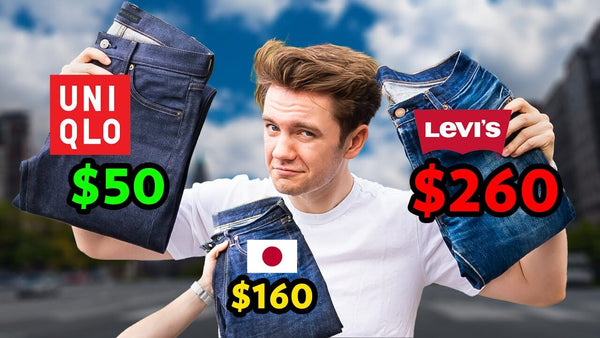Comparing Three Japanese Selvedge Denim Jeans ($50, $160, $260)
Sep 30, 2023
A Comparison of Uniqlo, Levi’s, and TCB Jeans.
Table of Contents
- Uniqlo Denim
- Levi’s LVC Denim
- TCB Denim
- The Levi’s Tax


Uniqlo Denim
-
Price: $50
-
Raw, selvedge, Japanese Denim
-
Micro Review: Probably the cheapest selvedge denim in the world – but you’d be missing out on the whole point of Japanese denim
If you want cheap selvedge denim, you’re probably thinking it’ll be made in China or Turkey or Bangladesh. Japan isn’t know for cheap denim – quite the opposite. Japanese denim is known to be expensive, prioritizing the very highest degree of artistry and craftsmanship. So how on earth can Uniqlo charge so little for their Japanese selvedge denim?


Uniqlo’s denim is developed with Kaihara Mills, the biggest Japanese denim mill in Japan. Kaihara mills can pump out denim like nobody's business and compete with the rock bottom prices we see in other countries.


Usually, these types of partnerships mean the denim’s cotton staple length, feel of the weave, and many other things are carefully chosen between the company and the manufacturer for a specific type of feel and look. But, in this case, it probably means that Uniqlo partnered with Kaihara for the sole purpose of creating the cheapest possible Japanese denim.

Source: Heddels.com

Source: Japan Denim
Kaihara Mills is essentially the equivalent of any of the massive denim mills you might find in Turkey or China – it is said that in any Japanese city, 1 out of every 2 pairs of jeans come from that manufacturer.

Country of origin affects the cost of products a lot. These jeans are made in Bangladesh. They’re great, they’re selvedge, and they’re inexpensive. But you’re missing the whole point of Japanese selvedge denim.

What’s so fun about Levi’s and TCB jeans is that there is some hand-stitching, unique texture (e.g. slub and nep), and weaving/general manufacturing techniques being used from the 40’s, 50’s, and 60’s – making Japanese denim a real artisanal craft that results in unique pairs of jeans. The whole point of Japanese denim is that it’s ART, not just any denim you can get from any mill. So, while these jeans are Japanese selvedge denim, we aren’t seeing all the fun.

Levi’s LVC Denim
-
Price: $260
-
Raw, selvedge, Japanese Denim
-
Micro Review: Authentic reproductions of older Levi’s jeans
The Levi’s 1967 LVC 505’s are more expensive because they are actually made, cut, and sewn in Japan and they are made in much smaller batches. Instead of trying to get jeans for the lowest price possible like Uniqlo is when working with Kaihara mills, Levi’s is trying to get these jeans as close as they can to the reproductions that they are selling (in this case, 1967 505 denim fabric with a talon zipper). They fit like they used to, look like they used to, and frankly…are EXACTLY what they used to be.


These jeans don’t come cheap – but NOW we are using Japanese denim mills in an artistic (and frankly, scientific) way.


These jeans are clearly far more expensive than Uniqlo’s jeans and there are a few reasons for that. We’ll talk about the BIG reason later but: manufacturing in Japan, import duties, etc. all contribute a lot to the price. TCB (our next jean) also says the price of their jeans is as cheap as they possibly can which makes these seem even more expensive.


TCB Jeans
-
Price: $160*
-
Small Japanese company
-
Raw, selvedge, Japanese denim
-
Micro Review: The best value on Japanese denim out there
*The price of these jeans will fluctuate with the exchange rate between whatever currency you are shopping in and the Japanese yen.

TCB (“Two Cats Brand” or “Taking Care of Business”) is one of the coolest Japanese denim brands ever to exist and offers their jeans at an amazing price compared to Levi’s (and most other Japanese brands). Instead of making separate reproductions of jeans from different eras like Levi’s does, TCB takes components of Levi’s jeans made across history and combines them to make really cool jeans. And, they do this to an extremely precise degree…maybe even more than Levi’s does.

The buttons are made of iron, meaning they will age and even rust over time – which a lot of people love (the whole deal with raw denim is that you can watch it age and break in, so things like this are a major perk for people into raw denim).

TCB puts a ton of thought into every detail of their jeans, from the shape, to yarn count, to truly, each and every seam on their jeans. They also use Zimbabwe cotton, which is considered to be one of the highest quality cottons in the world – it has one of the longest staple lengths of any cotton, meaning it’s stronger and softer than other types of cotton.

While Levi’s is focused on 100% era accuracy, TCB is not necessarily. For example, Levi’s probably wasn’t using Zimbabwe cotton in the 1940’s, but that’s the nice thing about TCB’s reproductions of older Levi’s jeans – they create them to reflect the techniques and features of that era as closely as possible, while also using the very best materials. It’s a win-win.
TCB’s jeans are unsanforized (most mass produced denim is sanforized to avoid shrinkage), meaning they will shrink A LOT more than sanforized denim. Unsanforized denim is used for a lot of different reasons – notably, unsanforized denim has a lot more texture than sanforized denim.


The shrinkage from unsanforized denim also creates a slight twist on the leg due to the uneven tension in the yarns when they shrink, which a lot of people really love (including us), but some don’t, so it’s about preference!
Also, the seams on these jeans are chain-stitched and are done with a vintage “Union Special” machine, which aren’t produced anymore. They use this machine because the seams pucker in a certain way that is known as “roping”, giving the edges of the jeans a really beautiful fading pattern.


How can Levi’s charge so much more than authentic Japanese denim brands like TCB?
With the crazy marketing and photography and advertising that Levi’s invests in, the cost for their products is quite high compared to smaller brands.

Another major thing to consider when looking at the price difference is…the Levi’s tax. Levi’s made the jeans that we all know and love today. Both Uniqlo and TCB are referencing Levi’s designs and virtually every jean in the world is based off of Levi’s.

Source: Levis.com
To put it in perspective, Levi’s invented or was the first to incorporate: rivets on pants, the red tab on the back pocket, the leather patch with red ink, and the red ticker on selvedge lines (actually that was Cone Mills, but still). The Levi’s tax is the idea that you are paying for the ORIGINAL jean. People go crazy over Levi’s because they are the brand that started it all – so they charge a bit of a premium for that.

The Takeaway
Are Uniqlo selvedge denim jeans worth it? Yes! They’re the least expensive selvedge jeans on the market. If you don’t have a burning passion for the artistry of selvedge denim, then it’s truly a fine choice.

Is Levi’s LCV denim worth it? Not really, unless you’re a mega-fan of the Levi’s brand and aren’t interested in jeans from any other brands.

If you are willing to look at other brands like TCB, Naked and Famous, Sugarcane, Unbranded, Oni, Pure Blue Japan – you’ll find better value there.

The Iron Snail is a men’s fashion vlog starring a young man named Michael and featuring a snail no bigger than a quarter. The two are set on taking over the world of fashion by creating a clothing line to end all clothing lines. Until then, we’re here to tell you EVERYTHING you need to know about the best clothing out there, from the highest quality raw denim jeans to the warmest jacket to the sturdiest boots…the Iron Snail has got you covered.
Taylor Hale is your friendly neighborhood tea enthusiast, amateur knitter, skincare nerd, clothing thrifter, regular flosser, accidental teapot collector, vintage IKEA lamp hunter, overzealous plant owner, beeswax candle-lover, gal pal, and obviously, very serious academic. She writes for the Iron Snail, as you can see.


